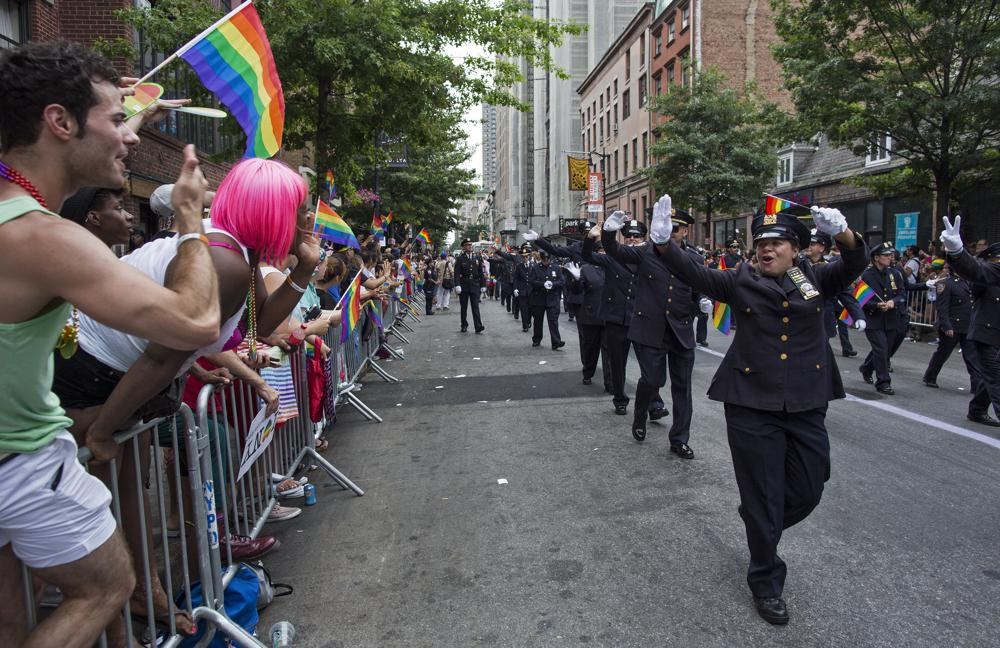Image credit: AP Photo / Craig Ruttle
BALTIMORE, MD– On Sunday, June 27th, skirmishes broke out between police officers and LGBTQIA+ marchers at the Queer Libration March in Washington Square Park, escalating as police began to arrest and pepper-spray people in the crowds. Reclaim Pride Coalition, which organized the march, has never allowed police presence since its establishment in 2019. Law enforcement’s disregard for this request raises concerns regarding the relationship between the LGBTQIA+ community and law enforcement that has been evolving since the 1969 Stonewall Uprising that Pride annually commemorates.
Some in the LGBTQIA+ community believe law enforcement has no place in a march that praises the rebellion of those who fought back against police brutality. To allow uniformed officers to march would be contradictory. Others believe that marching in uniform demonstrates the growth of the police department towards inclusivity. LGBTQIA+ representation and activism within this historically oppressive establishment may therefore lead to greater social change. Marching in uniform is important to many LGBTQIA+ officers, but NYC Pride just signed an official ban on uniformed police officers in light of ongoing conversations regarding police brutality.
Many officers feel excluded. “The bans came across to all of us as surprising and disheartening,” said Ravi Satkalmi, Deputy Director of Intelligence Analysis at the NYPD and member of the Gay Officers Action League (GOAL). “Anyone in the LGBTQIA+ community knows that the way to affect change is to first make yourself known. And so when there’s an organization saying you cannot openly identify yourselves as police officers, we think that that’s a step in the wrong direction. There are allies within the law enforcement, and those allies are important to affect the kind of change that activists are seeking.”
As visibility is key to broader acceptance by the public, Mr. Satkalmi believes that the uniform ban fosters a counterproductive and rather dated view of the police department in relation to the LGBTQIA+ community. Pride may be a protest, but the very presence of the uniform among parade-goers actually represents a message in agreement with Pride’s rebellious roots, he believes. “We had the head of NYPD’s largest union essentially say that if you are gay, you cannot be an officer,” said Ravi Satkalmi on the NYPD of the 1980’s. “We had to sue in order to have the right to wear that uniform and to march in that uniform in the Pride parade. So for us, wearing that uniform is a sign of protest.”
The workplace environment has evolved positively in the past few decades for LGBTQIA+ law enforcement members. The NYPD in particular has seen significant strides in LGBTQIA+ inclusion. In 2012, engagement between LGBTQIA+ organizations and NYPD leadership led to changes within the NYPD patrol guide to include procedures dealing with transgender, nonbinary, and gender non-conforming New Yorkers. The NYPD has also introduced specialized LGBTQIA+ training for recruits in which NYPD and GOAL members share coming out stories and propose hypothetical situations involving LGBTQIA+ individuals that recruits may encounter in the field. The training is not nationally mandated yet, but GOAL hopes to spread the practice elsewhere.
Regardless, there are individuals who are going to feel uncomfortable with police officers marching in the parades, especially those who are transgender or BIPOC. BIPOC individuals are disportionately targeted by law enforcement. Therefore the ban was also motivated by intersectionality. Heritage of Pride, the organizer of NYC Pride, released a statement on the uniform ban, explaining that their organization “seeks to create safer spaces for the LGBTQIA+ and BIPOC communities at a time when violence against marginalized groups, specifically BIPOC and trans communities, has continued to escalate.” Through the ban, NYC Pride hoped to recognize and respond to the needs of the community, even if it meant excluding a portion of it.
Police officers are still permitted to march, of course, just not in uniform. Even so, LGBTQIA+ law enforcement still feels shunned by the decision. Others feel as though the ban is only a small inconvenience that should be tolerated for the greater comfort of the community. “If you’re an officer… of course you should be able to celebrate and express your pride,” says parade-goer John Blasco. “But you don’t need to do it in a uniform that has perpetuated violence against many of the people who are trying to celebrate their pride that day.” And so the debate becomes a question of who is losing or gaining more by the ban. Understandably, the LGBTQIA+ community and law enforcement each have different relationships with the uniform, and so for each it will represent different values and experiences. If there is going to be any kind of progress, law enforcement will have to change the public’s perception of what their uniform means.



